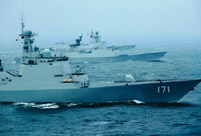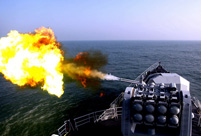

BOAO, Hainan, March 25-- Chinese Premier Li Keqiang on Thursday delivered a speech at the opening plenary of Boao Forum for Asia Annual Conference 2016.
The following is the full text of Li's speech:
A New Vision for A Dynamic Asia Through Joint Efforts
Speech by H.E. Li Keqiang
Premier of the State Council of the People's Republic of China
At the Opening Plenary
of the Boao Forum for Asia Annual Conference 2016
Boao, 24 March 2016
Distinguished Guests,
Ladies and Gentlemen,
Dear Friends,
I am delighted to be back for the Boao Forum for Asia Annual Conference and to meet with so many friends, both old and new. On behalf of the Chinese government, let me extend warm congratulations on the opening of this year's annual conference and give my hearty welcome to all participants coming from afar.
Just two days ago, Belgium was hit by serious terrorist attacks, and Prime Minister Charles Michel had to cancel his scheduled attendance and address today. Here, we give our deep condolences to the families of the victims. China stands firmly opposed to terrorism of all forms.
We gather here in Boao at the beginning of the spring season, on an enchanting and peaceful day. But looking at the global economy, we see difficulties lingering and undercurrents lurking. Boao brings together heads of government and leaders from businesses, think tanks and the media. I look forward to hearing your wisdom and insights about how we could together open up a new vision for a dynamic Asia.
Today, almost eight years after the international financial crisis struck, the ripples of its implication are still being felt around the world. The world economy is going through profound adjustments. Developed economies are experiencing slow recovery and emerging economies are performing unevenly. Global trade continues to contract, and both global commodities prices and financial markets are fluctuating. Geopolitical risks are growing, and uncertainties and destabilizing factors are on the rise. In Asia, the problems of underdevelopment and imbalances remain acute. Many Asian countries are faced with export decline, growing debts, and economic slowdown. Some have even witnessed sharp depreciation of their currencies coupled with faster capital flight. No wonder some say that the Asian economy is facing one of the toughest times in recent years.
While things may not look good, we must not lose confidence. The truth is, Asia has emerged only stronger from the two previous financial crises. Quite many Asian countries have become much more experienced as to how to beef up the real economy and fend off financial risks. Regional cooperation in Asia has also delivered fruitful results. Last year, growth in Asia was still faster than the global average. Asia's share in the global economy further increased, and Asia contributed to about one third of global trade. This part of the world has remained one of the most dynamic globally.
At last year's annual conference, President Xi Jinping put forward the major initiative to build a community of shared destiny and open up a new future for Asia. The theme of this year's annual conference is "Asia's New Future: New Dynamics, New Vision". The community that we are committed to build is one of development and cooperation. Asia is a major force for world peace and development, as well as a major engine driving world economic growth. It is also an important factor promoting progress of world civilizations. As long as Asian countries work together with firm commitment and unity, we will be able to get over difficulties and embrace an even brighter future. Along that line, I wish to share the following thoughts with you:
First, we need to jointly uphold peace and stability. When we drink water, we should not forget its source. Asia owes the past decades of rapid growth to an environment of overall peace and stability in the region. As the saying goes, good neighbors mean good life. The past sufferings of war and turmoil have taught the Asian people the value of peace. Asia's post-war development shows that at all development stages, we must stay committed to good-neighborliness and must never let the minor differences or disagreements between us stand in our way. It is through dialogue and cooperation that we could find the "golden key" to development. We need to continue to treat each other as equals and live with each other in peace, and we need to work together to increase common ground, reduce differences, and build a solid foundation for peace and stability in the region.
Second, we need to jointly promote economic growth. Emerging economies and developing countries now account for 40% of the global economy. They once contributed up to two thirds of the growth of the world economy, and played a major role in the global efforts to tackle the 2008 financial crisis. But things have been tough over the past two years, as some of them have experienced significant economic slowdown and even negative growth. Asia, which is home to the largest number of emerging economies, has on the whole maintained a strong growth momentum. Last year, the growth of developing economies in Asia reached 6.5% and accounted for 44% of global growth. Therefore, Asian nations should enhance confidence, foster new impetus of growth from within, and stimulate vitality to play a bigger role for economic recovery not only in this part of the world but also globally. It is our hope that countries in the world will join hands to deepen cooperation, form synergy, strengthen macro-policy coordination, oppose trade protectionism of all forms, adopt more growth-friendly policies, and try to avoid the spillover effect of the policy adjustments in certain countries. China proposes establishment of an Asian Financial Cooperation Association, and China stands ready to work with all parties to improve Asia's financial market and prevent massive regional financial turbulence from happening again.
Third, we need to jointly deepen integrated development. To achieve development and prosperity in Asia, we must make sure that no one is left behind. China hopes to align its initiative of building the Silk Road Economic Belt and the 21st Century Maritime Silk Road with the development strategies of other countries in the region and regional organizations. Together, we could foster a new pattern of regional development through integrated planning and production and coordinated actions. China is ready to provide high quality and cost-effective equipment and production-lines that could tailor to the needs of Asian countries. We may carry out production capacity cooperation in infrastructure building and industrial equipment making. The Regional Comprehensive Economic Partnership (RCEP) is the biggest regional trade arrangement in Asia that attracts the largest number of participating members, and we hope that negotiations under the RCEP could be concluded by 2016. For the Asian Infrastructure Investment Bank and the Silk Road Fund, their priority should be placed on serving developing countries of Asia first, and on connectivity and production capacity cooperation projects, so that people in the region could share in the benefits of such integrated development.
Fourth, we need to jointly uphold openness and inclusiveness. Being open and inclusive is the fine tradition and very basis of Asia's culture. In Asia, over the millennia, different nations, religions and cultures have coexisted with and learned from each other and all have contributed their major share to the progress of human civilization. Almost all religions with world-wide influence originated from Asia. The people in Asia crave for peace, good-neighborliness and harmony. It is this piece of land that has given birth to the Five Principles of Peaceful Coexistence, and brought into being the Asian way, highlighting mutual respect, consensus building and accommodating the comfort level of all parties concerned. Asian countries are linked by close people-to-people exchanges. Each year, several hundred million tourists travel among Asian countries. We need to make good use of all dialogue platforms in Asia to deepen people-to-people exchanges and enhance the unity of Asia. China proposes that an Asia Civilization Dialogue Conference be held and we welcome all countries and regional organizations to take an active part in the conference. The more challenging the task of development is in the region, the more imperative it is for us to join hands, build on our traditional friendship and pool our collective wisdom, so as to carry forward the Asian Consensus and achieve our common pursuit for development.
Fifth, we need to work jointly to trigger innovation. Innovation holds the key to development. Asia is home to 48 countries and over four billion population, and the "Asian miracle" was created by the talented and hard-working Asian people. To keep up the momentum of prosperity and development in Asia, we need to give full play to Asia's unique advantage of abundant human resources, and bring out the potential and creativity of all its people. Asia's new future relies on innovation and talented personnel. We need to improve education and training in Asia to build a high-quality labor force, strengthen the talent pool and increase productivity. We need to step up R&D investment, adopt new models of development, including the "Internet Plus" model, and build cooperation platforms for innovation to develop the new economy and a shared economy. We may also conduct due exchange of experience. This way, the hundreds of millions of our people, especially the young people, will have the chance to engage in innovation and entrepreneurship, and have their ingenuity and creativity fully unleashed. This also allows countries in the region to quickly embark on a path of innovation-driven development and upgrade the level of growth.
Ladies and Gentlemen,
China's development is closely linked with that of Asia, and I know that many friends are interested in the economic situation in China. So I wish to take this opportunity to say something about how we should look at the Chinese economy and what we intend to do in China to ensure continued growth.
First, how should we look at the Chinese economy? China's total GDP last year was RMB67.7 trillion yuan, or over US$10 trillion. Every move of this economy attracts world attention. Meanwhile, China is in the process of structural readjustment, and there is divergence among different regions and sectors. This is like what a Chinese poem says, one gets different impressions of a mountain when viewing it from the front, sideways, at a close range or from afar. Given the sluggish growth of the world economy, the lowest ever in six years, and with the Chinese economy undergoing transformation and upgrading, it is simply natural that different people may see the Chinese economy differently.
In my view, when we look at the Chinese economy, we should first of all look at its overall performance. Last year, China grew by 6.9%, a bit slower than in the past, but still one of the fastest among the major economies. It was achieved on the basis of the huge size of the economy which was in the process of transformation. Since the beginning of this year, the Chinese economy has on the whole enjoyed steady performance and seen new, positive changes. The number of measures we introduced to promote steady growth, restructuring and reform are being paid off.
Second, we need to look at the overall trend of the economy. According to the National Bureau of Statistics, over 13 million new jobs were created in China's urban areas last year, and the growth of people's income was faster than that of the GDP. The employment situation in the first two months of the year has stayed basically stable, with surveyed unemployment rate standing at around 5.1% in 31 major cities, roughly the same as last year. As industrial upgrading picked up speed, the service sector, high-tech industries and equipment manufacturing industries all maintained fast growth. Domestic demand continued to rise, and consumption growth stayed at double digit. Consumption and services have now become the main drivers of growth. Both energy intensity and the discharge of main pollutants went down, an indication that the quality of growth is getting better.
Third, we need to look at the prospect of the economy for the long run. China has become the world's second largest economy, but its per capita GDP is still at the middle level in the world. There is both a gap to fill and a potential to tap, especially in China's central and western regions, where we see huge space and room for development. China is now in the process of industrialization and urbanization. There is strong impetus for reform and much space for expanding domestic demand. Development is resilient, and the tools are many to boost innovation. The fundamentals of the Chinese economy have stayed unchanged and will remain sound in the long run.
Of course, we are fully aware that the Chinese economy is now deeply integrated with the world economy. Some international agencies have lowered the growth forecast for this year and destabilizing factors and uncertainties are on the rise. The impact will be felt in the Chinese economy. At the same time, in China, the deep-seated structural problems have become more prominent, and the economy still faces growing downward pressure. As the economy goes through transformation and upgrading, temporary problems have occurred, and companies in certain industries are facing a hard time with their operation. We will not dodge these problems. In fact, knowing where problems are have made us all the more confident. We will expand aggregate demand as appropriate, and at the same time press ahead with structural reform, supply-side structural reform in particular. On the whole, for the Chinese economy, we believe there are more hopes than difficulties.
Next, what do we intend to do to ensure continued growth? The Government Work Report adopted by the NPC has laid that out in great detail. Yesterday evening, we took the bullet train to travel from Sanya to Boao. A bullet train is powered not just by its locomotive, but also the facilities installed in between carriages. If we are to compare the Chinese economy to a bullet train, what we need to do is to keep it steady and move at a reasonable speed. With growing environmental and resources constraints, high-speed is not economical; nor is it environment friendly or sustainable. Our goal is to maintain medium-high speed of growth. China's development will be guided by the new vision of innovative, coordinated, green, open and shared development. We will continue to give priority to development, and work to build dynamic engines to propel the economy, making sure that it maintains medium-high speed growth and moves towards the medium-to-high end of development.
 |
 Train rides through blossoms
Train rides through blossoms HD pictures of battleships of PLA Navy
HD pictures of battleships of PLA Navy East Sea Fleet conducts combat drills
East Sea Fleet conducts combat drills Sophie Marceau goes square dancing in Guangzhou
Sophie Marceau goes square dancing in Guangzhou Police officers learn Wing Chun in E. China
Police officers learn Wing Chun in E. China Charming models compete in super model contest in Beijing
Charming models compete in super model contest in Beijing Thai most beautiful transgender Nong Poy release new photos
Thai most beautiful transgender Nong Poy release new photos Now and then photos of Shanghai Jiaotong University
Now and then photos of Shanghai Jiaotong University Is this what air travel will look like in 2050?
Is this what air travel will look like in 2050? Top 20 hottest women in the world in 2014
Top 20 hottest women in the world in 2014 Top 10 hardest languages to learn
Top 10 hardest languages to learn 10 Chinese female stars with most beautiful faces
10 Chinese female stars with most beautiful faces China’s Top 10 Unique Bridges, Highways and Roads
China’s Top 10 Unique Bridges, Highways and Roads Nuclear tests, border crimes change Chinese's attitude to N.Korea
Nuclear tests, border crimes change Chinese's attitude to N.Korea  Tax rumors spur buying of foreign products
Tax rumors spur buying of foreign products  Mekong cooperation has promising future
Mekong cooperation has promising future  Transplanted New Yorkers talk culture shock and urban affinities
Transplanted New Yorkers talk culture shock and urban affinitiesDay|Week